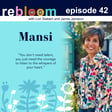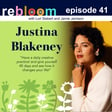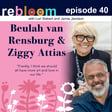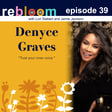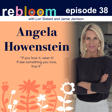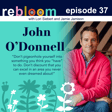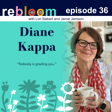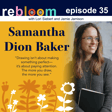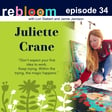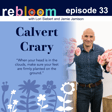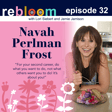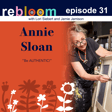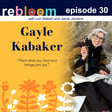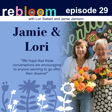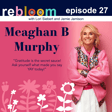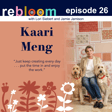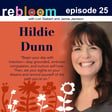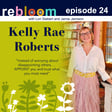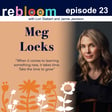Introduction to Creative Rebirth
00:00:01
Speaker
Do you have a dream that is a small seed of an idea and it's ready to sprout? Or are you in the workplace, weeds, and you need to bloom in a new creative way? Perhaps you're ready to embrace and grow a more vibrant, joyful, and authentic life. If you answered yes to any of these, you are ready to re-bloom. Welcome to the podcast where we have enlightening chats with nature lovers, makers, and artisans as they share
Meet Lori Siebert and Jamie Jamison
00:00:30
Speaker
inspiring stories about pivoting to a heart-centered passion. Hello, I'm Lori Siebert, and I am very curious to hear from friends and artisans about the creativity that blooms when you follow your heart. And I'm Jamie Jamison, and I want to dig deep into the why behind each courageous leap of faith and walk through new heart-centered gardens.
00:00:54
Speaker
Each episode of Rebloom will be an in-depth conversation with guests who through self-discovery shifted to share their passions with the world. Get ready to find your creative joy as we plant the seeds for you to Rebloom. Well, hello, everyone, and welcome back to another episode of Rebloom. I'm Jamie Jamison. And I'm
Mary Jo Hoffman's Journey from Aerospace to Art
00:01:20
Speaker
Lori Siebert. Hi, Lori. How are you today? Oh, my God. I'm so excited to talk to Mary Jo because I just listened to her on Margo Tantal's Wind to Silt Chats, which is another great podcast. And she's amazing.
00:01:34
Speaker
Folks, you are in for the biggest treat today. We are going to talk with Mary Jo Hoffman, who had an incredible rebloom in her life. She was an engineer, probably, so I guess she would still say she is an engineer and not just any kind of engineer, an aerospace engineer. And along the way, she has had a major pivot and she is now an incredible photographer and has just come out with a beautiful, beautiful new book called Still. And so we are so excited to welcome Mary Jo today. Hi, Mary Jo, how are you?
00:02:15
Speaker
Hi, Jamie. Hi, Lori. I am great. I am great. And I'm super happy to be here. Thank you so much. So Mary Jo, we are calling you in the middle of a heat wave um in the summertime. But you hail from Minnesota, don't you? Yes. Yeah. I'm in I'm in the suburbs of the Twin Cities. Yeah. We're having our own little heat wave to here. So we get the same weather as you guys. It's it moves across the United States usually. And you get about the same weather we had about two days ago. Fantastic. Fantastic. Yours is milder. Your weather's milder because of the ocean. Well, yeah. Spring is a long time coming to you. And so when does summer when did the seasons kind of when does summer start for you actually? yeah
00:03:02
Speaker
Well, that's a really good question because, um you know, there's meteorological summer, which starts on June on the solstice. ah the I'm sorry, there's the meteorological
Seasons and Personal Growth
00:03:15
Speaker
summer that starts on June 1st. There's the astronomical summer that starts on the solstice, June 20th this year. Um, and I actually have, ah it you know, that's a really good question for me. When does summer start? Because I, for me in the North, I say that for me, spring starts when I see the pussy tail, the, the, the, um,
00:03:38
Speaker
Pussy willows burst. That's when spring starts. And fall starts when I see the first sumac turning, the staghorn sumacs. And winter usually probably when I see the first skim ice on ah on the ah swamps and in you know in December. So I don't know if I have a specific seasonal transition into summer. And i that's a shortcoming on my part. I have to think about that. Maybe when I see the first butterfly, I have to think about it. You're such a perfect person to have on this podcast that's based on reblooming and pivoting because you pay such close attention to the seasons
00:04:20
Speaker
in nature and and you've had many seasons in your life as we all do and you were once an aeronautical engineer which that blows my mind to yeah pivot to to what you're doing now. So, can you share a little bit about how that happened? Yeah. That pivot, yeah. Yeah. So it's interesting, I just turned 60. Happy birthday. When is it? May 22nd. I just had a birthday too. I thought maybe we were the same day. Yeah. Oh, yeah, yeah.
00:04:57
Speaker
And um so yeah, you know, if you think about it in terms of like 20 year segments, i if you think of those first 20 years as becoming, you know who you are. um And then the next 20, you know, i I worked as an aerospace engineer. I went through engineering school. um And I went into it for no other reason than an aptitude in mathematics and it made college easy when you're good at math, you know, and it was so much easier to do a problem set for homework than to try and write a paper.
Corporate Life to Creative Freedom
00:05:30
Speaker
And ironically, no, I've published a book, which is really ironic because I, you know, I did spend my whole life avoiding writing papers. Um, so I went into mathematics because I was good at it and, um, and, uh, ended up being so good that I got full scholarship to go to Stanford graduate school in aeronautics and astronautics. And I picked that because it was the most math-based of all the engineering. And so it wasn't necessarily a calling. um But I did enjoy it. I was good at it. And then I practiced it for 2017 years. I was in corporate R and&D for Honeywell, who does all the avionics for all of our eight all of our flight vehicles and satellites and space vehicles.
00:06:20
Speaker
And so my group did flight controls. Um, so it's think of autopilots, you know? And so, and by the time I left, I was there 17 years and it was corporate research. And by the time I left, um, as director of the lab and we had people on four continents and, um, I loved what I was doing. I really loved what I was doing, but then my company got acquired and I didn't, really liked the new company. It was a big industrial conglomerate and I wasn't feeling it. And ah my husband and I had put off because, well, because we were having fun, honestly, you know, making corporate kinds of incomes and no kids, we were traveling all over and
00:07:06
Speaker
And we put off family planning, so it was time to be serious about, to get serious about that. And I, by then, when I was director of the lab, I was flying all over the world, and so that doesn't work well for family planning. So
The French Break and Birth of 'Still'
00:07:20
Speaker
um I quit, and we changed roles, and he became ah He went to work, he had been home with our first daughter and he went back to work as the primary breadwinner and I stayed home and we had another child. and um So that that's my aerospace career. But then you know I was heads down with Littles. I found Littles really tiring, really exhausting. I can't imagine. i you know
00:07:45
Speaker
ah Anyway, um ah you know, I wasn't looking for anything additional during those years. I felt pretty full up myself. And then um but as soon as my youngest went to ah elementary school, you know, you have those what you think is going to be six hours a day to yourself, but turns out to be just a couple hours a day. So it's a couple hours a day to yourself. So I think I had always been like a maker as a kid. I probably in a different household in a different era in a household that had maybe some margin, you know, some like financial margin. I would have been a creative kid, but you know, this wasn't
00:08:26
Speaker
ah You know, um my mom had her hands full, let's just say. And um so I had always been a maker and a creative kid. But um and then in college I picked up the camera and ah my roommate introduced me to photography and I did Um, enjoy that. So I was became, I had become an hobbyist, an amateur photographer, which I did those 20 years I was working corporate. And, um, so when the, my son went to school, elementary school, and I had a few hours a day, my, it happened when my husband and I had taken a sabbatical from our busy, busy middle messy, I call them those messy middle years. We got the little kids.
00:09:07
Speaker
Multiple careers. I mean, it's chaos. You don't even know how you're getting through it. just You just do it. Yeah. Yes. Yeah. So we put our life on pause and put did a sabbatical in Southern France and so in order to put the kids in school and there so they could learn French. And we had now we actually did have six hours a day free. So I had said to my husband, let's practice for retirement because we're in our mid 40s now. He started writing and I started this photo a day project called still that we're going to talk about. And, um, both of them, here we are 12, it's exactly 12 years later, like almost to the date. And he's got a book coming out on July 9th. My book came out on the first, it's incredible both based on those, those things we started while we were on sabbatical. Yeah.
00:09:59
Speaker
It is. It's an incredible story. Yeah. You know, it's incredible. Well, first of all, you started it on January 1st of 2012, which I think you probably should get the Guinness Book of World Records for holding your New Year's resolution the longest because we all give up. But I'd like you to talk about that, that resolution that you made or that thought that you had that day and also share with us because there's something beautiful that you talk about in your book about the seasons. And as you said, as we were talking about earlier, we do have seasons of life. I like to think that there are sort of four, I mean, if you're going to simplify it, maybe four seasons or our early years would be like spring, those middle years, 20s, 30s, more like summer, um the 40s, 50s, a little more like fall, and maybe yeah retirement 60s, a little more like winter.
00:10:56
Speaker
But we need to keep growing in all of those seasons. And I love in the book, you talk about micro seasons. And it seems that in 2012, you discovered your own micro season. And yeah, and you've held on to it, but you've continued. Can you start there and tell us about that pivot? Because it's so beautiful. It's a great story. Yeah. So I, um it's interesting you say it was a New Year's resolution because you're absolutely right. I started it on January 1st, which, and the funny thing is I don't do a New Year's resolutions. I don't because I can't keep them and I know I can't keep them. So I don't even bother.
00:11:39
Speaker
um And just, you know, to say for 20 years, I'm going to try and lose weight would be ridiculous and boring. So I just don't bother. So um but it's I did start January 1st and I didn't stop. It's the interesting thing when I started the project, it was a one year project. So I was going to do a one year creative challenge. And I committed to that one year. And it's, an in you know, a lot of people join these challenges, these one a day challenges, because that outside accountability is so important when you're sharing with a group. And I'm all for it. And I recommend people do it. I didn't join a group. I i didn't need that outside accountability. And i it never occurred to me that I wouldn't make the year. Like i once I decided i to do the year, I was going to do a year of photos.
00:12:28
Speaker
So i i I did do that. I started in January in Minnesota, which is really funny to start a nature blog in January in Minnesota. Talk about winter. I thought through a lot of things, and I did not think through that. um Found nature in Minnesota in January, and I still had three months of winter to get through before things started to happen. so that But I did, when i when I formulated the project, I did have a lot of foresight. I call it dumb luck. people have corrected me and said, no, it was intuitive wisdom. i I still feel it was dumb luck. But one of the things I did is I made sure when I formulated the project that then
Photography Challenge: Process over Perfection
00:13:10
Speaker
and I didn't understand then at the time, i I didn't understand anything. I just signed up for a one eight a one a day project. But I didn't understand at the time when you make that commitment, you're committing to the process.
00:13:22
Speaker
not to the results. And so you're just committing to not breaking that chain. And I didn't understand that at the time, but what I did have the foresight to do is make sure that the minimum requirement to not break the chain was very small so that every day I could do it even on the days where life happens. that and That's really it's an really important thing. And, you know, very similarly in 2015, I challenged myself to post a picture on Instagram once um once a day for a month. And I thought, I don't know that I can do this. And then I thought I did it for a month. And then I i did the same thing. And I thought, all right, I'm going to post every day for a year. I also haven't stopped since 2015. I've been going
00:14:13
Speaker
every single day. You're not, you're was ah almost years. Yeah, almost 10 years. And I, and I love, when I was reading that you had done, you had said this, I'm like, but oh my God, we're sisters, we're soul sisters, you know, we're chained together by this. that space Because but like you, I felt, and while mine, while I'm not photographing every day, I'm posting or i'm at I do a little bit um differently with the flowers, i'm I often take them, but I'm i'm still creating every day.
00:14:46
Speaker
And I look at that as my, I don't know, it's my daily meditation. It's my daily, it's just, it's connecting. And I was afraid, like the diet in January, because I failed it like it's week two, um that if I stopped, that I would stop. And it's just something that, and but the gifts from continuing And keeping that chain alive are just incredible. Okay, so we our story is identical. we yeah you and you we you Should I turn her around? No, no. Because our story is exactly the same. I was just going to share also that I can't stick to anything usually because I like to do so many different things but I wanted to do the hundred day challenge so I chose doing post-it drawings because I thought surely what I can do a post-it drawing every day and i I am not consistent in doing them every day but I do them consistently, inconsistently or whatever and now I have this whole journal full of them and they they inform
00:15:52
Speaker
all the like a lot of work that I'm doing now. So yeah, and I love that idea of process in the journey versus having a perfect solution at the end because I think I think people always they will they stop themselves a lot from the exploration in the play because they want the they want a result that's perfect. And I think like what you're doing, you your work just gets better and better and better the more you're in it and trying and doing and playing. You learn.
00:16:29
Speaker
Yeah. Yeah. and the You know, I've since um I wrote the book and I give a lot of workshops now and so I talk about the power of these daily challenges and there's so much science and there's so many reasons why they're effective and why they're powerful and how they override the perfectionist by shifting that focus from the product, from the results to the process. Then the results happen and they do happen. They happen like by magic on their own. and All you're committing to is not breaking the chain. And so it's so powerful. But there's, you know, it overrides perfection. It snaps you out of autopilot. It builds confidence because of that, rap you know, that daily play. I mean, there's so many reasons why these things work. That's why they're popular. planning seeds and you never know what is going to bloom and what's going to grow and I and sometimes when I'm speaking
Creativity in Daily Practice
00:17:25
Speaker
right people I'm like look I had no idea
00:17:28
Speaker
at the end of this or in the middle of this, that I would be doing X, Y, and Z. That wasn't the goal. It was just to put joy out into the world. It was to share beautiful flowers and to just share some different stories and share my life. But by putting that out there, it led to other things. And you don't know. Just do it. Just put it out there. Allow yourself to be creative. Right. Put it out there. ah You mentioned, you like used the word calling, a calling. And I feel like so many times in our conversation that that idea pops up and people might go down a road that they they thought they should. I guess yours was because you were good in math. But then I feel like maybe this project is more of a calling for you. Would you say that?
00:18:21
Speaker
That's a good question. ah It's certainly coming back, yes it's like if yes. If it's a coming back to myself, um for sure. I was a kid that played outside all day. i You know, nature was probably my first love as a kid. um and I was a maker but that just wasn't you know ah in in the fabric of our family as I grew up. So I would say it it's a coming back into myself and the original joys and interests I had as a child. Is it a call like a calling seems like it's something calling from outside and I feel like I
00:18:59
Speaker
But it could be a calling from inside, too, I guess. So, yes, I would say it is. I do feel like I've come back into myself as, you know, a 45-year-old woman, if you will. I feel like, though, if you have a math brain, photography is a perfect match for that. Because I do not have a math brain. And when I took four by five cameras in college, it stressed me out. So I think like you've all through your life, you've picked up you know your math skills, blended with your photography skills, blended with your love of nature, and then put that all together into this beautiful, beautiful book. Well, and you know what you see too when you look at this but this book is you see both right brain and left brain. You see the the way that a mathematical mind would work because things are
00:19:52
Speaker
done in grids or they're, I mean, they're perfect. They're gorgeous. But then you also see and you see the beautiful art and and you're creating art. So you're and that's when we talk with people about pivots when they want to pivot creatively. It seems that that's always missing in their life, that creativity. And when they find it, for they realize that that's just as important to them in their daily routine. as eating and breathing and they need that creativity. What is bringing that creativity into your heart and your soul in your day done for you? Yeah. Yeah. So I absolutely, ah you know, I brought my art, if you look at it, you can see the scientist in there. It is very gridded. It's very, you know, geometric. I love patterns. I like, like
00:20:44
Speaker
you know, tessellations. And I love seeing mathematical expressions and nature. They're everywhere. um So when I pick a subject, it's often because that I like that expression of the mathematics behind it. So you can see I have brought those two things together. I do think the left brain, right brain discussion is fascinating because like I like creativity. I believe everybody's creative. I also believe I don't think i don't know i don't i know. I'm less confident about this, but I do think we all have left brain and right brain capacities. and For some reason, in our culture, they get, we're too young. Even in childhood, you know it's mom saying, oh, she's the artistic one and she's the smart one. You know what I mean? Those simple comments where,
00:21:37
Speaker
we start to shut down ah certain ah pathways or we start to you know focus or overbuild or over-develop one side of our brain at the expense of the other. I do think many more people and maybe all of us are both left brain, right brain when we are born and then it just gets atrophied over the years. you know i An engineering curriculum, once you get on it, you do not, there's no room for liberal arts yeah or art. edge you know there It's a full schedule.
00:22:10
Speaker
and ah and And if you step off the path at all, you're looking at a five or six year undergraduate program. So it didn't allow any exploration. So, you know, for seven years of higher education, I overdeveloped one side of my brain, even though I had been a maker as a kid. I had, you know, I love experimentation. I love play. um And so that happens to all of us, I think. And I i do think that left brain, right brain is is ah more natural, more normal, more common than we think. But I don't know what happens it once you over develop one side.
00:22:50
Speaker
how to get you know how hard hard it is to get that back. Well, and it's interesting though, through the process of still though, you've really been developing that left brain for the past 12 years. I mean, i wouldn't you know it's interesting and you're right, over developing, under developing, but it's made you so much more aware of the world around you. And just, yes I think that's the interesting part too, is when we allow creativity to be part of our life i know when i really got serious about photography i started to look at the world completely differently i looked at shapes i looked at light i looked at isn't it senator our sons yes and and entire new world because you're not just going through it in a surface way, you're really saying, oh, do I find, you know, where it it could be as simple as looking at textures or patterns, but you begin to see that and you really begin to see your, is that what you noticed as well when you started this? is ah Absolutely. Matter of fact, I took a few photography classes when I was in my twenties and thirties and I just remember those simple exercises where they would say, just go out and the photograph blue, yeah just blue.
00:24:04
Speaker
And suddenly the same four city blocks that you've lived in for 10 years looks completely different when all you're doing is looking for blue. Oh, I love that. Yeah, that's a great idea. Yeah. why do Try it. Do it today. I mean, go out for a walk after after you're done today and just notice blue. I mean, pick a color. Just don't pick the green. And you will see your neighborhood completely differently for for the next 30 minutes. It's really fun. It's really powerful. So yeah, carrying a camera does that.
00:24:38
Speaker
um Looking for my subjects, my nature subjects, it's a treasure hunt, right? I mean, I go outside and I'm looking and and I do, ironically, I do exactly that to this day because if I go outside right now, it's a wall of green outside. It's just green on leaves on leaves on leaves, green on green. It's hard to see past that wall of green to try and find a new subject. And so I will leave the house, walk the dog, leave the house and say, I'm going to only look for orange. I'm just looking for orange today, you know, because I have to do something to to narrow my focus. Otherwise, it's overwhelming. It's just overwhelming out there. So I do I use that. I call it spotlighting technique. I love to do. um I was just in Hilton Head and we had a walk to a boardwalk to the beach. And I love looking for different shapes of leaves. And I know you have grids that show that in your book. Yes. yeah And so I would just on my walk, I would just collect all these different leaf shapes. And then I had my jelly plate with me. So I was doing mono printing back at the at the beach house. bay Yeah, i'm I'm kind of annoying to my family because I'm always like following behind. They're always like, come on, Laura, because I'm looking on the ground and looking in the leaves and looking in the sky and
00:26:00
Speaker
And I feel that that is a ah gift that we have when you do start to notice things that, you know, there's just so much beauty and wonder in nature. there There's so much. and And I will say, you know, it's funny, I have the most patient husband and when we walk. He knows that often I'm going to stop and photograph something, especially if it's a flower. And I was fortunate to listen to a National Geographic photographer one time. And he said, you know, everybody's so busy looking at the sunsets or the sunrise. And he said, turn around and look what it's shining on. on
00:26:35
Speaker
And because I'm always looking for light. How is the light hitting something? yeah And that was one of the best pieces of advice. So every time, it's funny, my husband will even, when we're at watching the sunset, he'll say, look around, look at the clouds. Like he's always spinning me around. yeah turn And I that. And I think it's interesting, we are doing that now in our creative brains, but we also get our family to start looking at stuff too. And they they see things differently. And I think you bring them into the mix. And I know you talked about your own children. I know my children have been brought into the fold of what I've done and I love that they see things creatively. Their friends love it, that I do things in a creative way. I know Lori's do as well. Talk about your kids in this journey too.
00:27:22
Speaker
Yeah, you know, the project and I picked nature. Well, I'm a nature lover, but the whole family is and we live in a three acre wooded lot. So nature made the most sense. But um the kids got on board right away because I had to find a daily subject. It really was a treasure hunt. Right. I mean, I was walking the dog while they were in school, but often my, you know, my kids for middle school, they could bike to school. You know, my son would be coming home down the driveway with something dangling from his fingers, you know, on the handlebars because he found something, you know, found something on this on the sidewalk. So they understood the the fun of it, you know, the fun of finding the fun of noticing. And then as they got older, I mean, 12 years is a long time. My son is 20 now. He was about that when I started. I imagine that. I mean, he was just that little Christopher Robin looking, you know, eight year old.
00:28:17
Speaker
Now he's six foot three and 20 years old. But my daughter, so my daughter, you know, she started with, they started with helping me find, you know, and they're, they're cute because they were cute because they knew how much I liked seed pods. I love seed pods. or Yeah. Yeah. I love how you like your shapes and leaves. I like seed pods and I will stop for a seed pod anywhere. And so the kids know that. And so the, you know, we can be driving and somebody who will yell, seed pods, you know.
00:28:48
Speaker
So anyway, um the kids really got into it. And then eventually my daughter got into helping me with composition. And now she's a designer. So yeah, the funny thing too is the cover of my book, my so that was my son's composition. Like I can't even take credit for it. I had all sorts of specimens laying on a table and like things pile up and then every
Family's Role in Creative Expression
00:29:10
Speaker
few weeks I just sweep them all up and throw them back outside. And I'd said he was probably 12 or something. I said, Joe, help me with the composition. And he never would. yeah You know, he he just would walk past. And so one day he stopped and he walked around the table and he just picked up a dozen items and he put it on my white paper.
00:29:29
Speaker
And I said, oh my gosh, those are big still colors were harmonious. And I said, how did you do that? And he said, oh, I just picked the most interesting shapes. And then walked away. That's interesting. interest Out of the males and babies. I know. And that's the cover of my book. I mean, you know, I like it's amazing. Let's take a quick minute and thank our amazing sponsors. Our podcast is proudly brought to you today by Jet Creative and Urban Stems. Jet Creative is a women-owned marketing firm committed to community and empowerment since 2013. Are you ready to rebloom and build a website or start a podcast? Visit jetcreative dot.com backslash podcast to kickstart your journey.
00:30:15
Speaker
They will help you bloom in ways you never imagined. And bonus, our listeners get an exclusive discount when you mention Rebloom. And a huge thanks to Urban Stems, your go-to and our go-to source for fresh, gorgeous bouquets and gifts delivered coast to coast. Use Bloom Big 20 and save 20% on your next order. And don't forget to subscribe to this podcast and follow us on Instagram and Facebook at Rebloom podcast. Thanks to our sponsors and thanks to you for joining us today. I love how you talked on Marga's um podcast about how create raising creative children and you did that because you were modeling it and our little five year old grandson, he'll often come home with
00:31:08
Speaker
weird things in his pockets because he walks around the playground and he puts things in his pockets and he ends he will unload and she's like, what is all this stuff? He goes, well, I have to put the stuff in there for my projects because if I don't put it in my pocket, the teacher will flow it away. So he all he and I'm like, I just crack up because I'm so like that. And my daughter is not ah like she is so interesting, but she's also You know, she likes a little bit things neater. So him bringing home this oddball stuff every day. He's all he's a collector already. I love it. I love how you can see all that. So yeah. You know, with ah my book, what's interesting is the number of people that are DMing me that they're how much their grandchildren
00:31:59
Speaker
are enjoying it and reacting to it, how much they're enjoying seeing their grandchildren react to the book. Don't you just that? That you're inspiring them and so many people? yeah and I mean, I got a download of photos the other day, a woman ah that had hurt shown her grandson my book. They went out, went foraging, and they came home and made compositions at the dining room table. And then he was only a young kid because he could barely hold the camera, but he needed to take pictures. It was adorable. I'm totally going to do this with Holden and Nash because they will
00:32:34
Speaker
You've created a movement. It's not just a book. It's a connection. It's a connection. You're connecting people through nature. You're showing us how to be treasure hunters. You're showing us how to connect. And I love it, to connect to the things that are common but are still yet beautiful. It's finding the beauty in... I mean, I love the things that are discarded. I love too that you talk about it's not just the full bloom, it's the bud. I dry peonies. Well, I absolutely adore peonies and they're gorgeous to photograph, but I dry all of them. I find them as gorgeous as the blooms themselves. for a completely different reason. And so I love that you're finding things that are dried, things that have passed. I mean, you're showing us the beauty in all of the seasons of nature. And it's amazing. Yeah. If you do this every day for 12 years. Yeah. I mean, honestly, you get...
00:33:40
Speaker
board with you do the perfect peony. yeah You know what I mean? like it but ah Peony is gorgeous. I love it too. It's one of my favorite flowers. But at some point, you know and then you yeah you you know for me, Peony Buds are fascinating. They you know the the the the they look like those... Shooter Marbles? Do you remember Shooter Marbles? I saw them too in the sticky and... Yeah, I love them. I love them. For me, I was out of necessity because I had to fill every day and so I couldn't always just do things in peak form. But then it was very quick where I realized, oh, this is more interesting.
00:34:18
Speaker
Then, you know, so I'm I'm actually photographing peonies spring, summer, winter, because the seed trees are awesome, too. Right. The seed pods are fantastic. So I'm I'm photographing them out of necessity for, you know, through every season of the year. But um and then you realize, oh, they're more they're almost more interesting in these other seasons. they really They really are. And, you know, I want I'd love for you to talk just a little bit to um one of the things that you talk about in your book. is you're, as a photographer, you shoot on white and you shoot on a white background and then you kind of pivoted a little bit and you were shooting on black and then you were getting some, but you know, the the experts will call them, don't do this, do that, do this. How do you both, and sort of two parts, ah two two questions, um own your own style and say,
00:35:14
Speaker
OK, great. There's going to be all these other voices going on. How do I own it? But also, how do you continue to grow and evolve? Because to your point, we sometimes do get bored. I've been doing it for eight, nine years, too. I get it. I get the need to pivot and grow. Yeah. So owning your style and growth within it. how Yeah. Yeah. So I wasn't a professional photographer and I do think that naivete was to my advantage.
Embracing Unique Artistic Style
00:35:40
Speaker
um and I mentioned my husband's publishing a book. He wasn't. He started by writing food articles for magazines and he wasn't trained as a journalist. And I think that worked to his advantage. He came in with a completely different voice they had never seen before because he didn't know the rules of short form writing. So I do think so so when people say I got to take a class first, i I'm a little bit
00:36:07
Speaker
Like Tae classes for sure. I get inspired by classes. I teach workshops. But also like I, you know, that naive of Tae, it's a powerful thing. So it anyways, I started on photographing on white and I had several people after I started and I picked white because I'm a um minimalist. I like Scandinavian design. my house is painted white therefore I could use the floors and the walls as as my studio and it was practical it was also my aesthetic and and when I after I started the project and I started showing professional photographers they are like well this will be dismissed as commercial art this is this isn't fine art this is commercial art and I said well
00:36:50
Speaker
commercial or fine art, I didn't even know there was a distinction and I'm just doing a creative project. Like I don't, you know what I mean? yeah they got yeah i it But yeah I think had I been a photographer, that would have shut me down. I mean, I think it would have shut me down. So it my ignorance was actually ah strength at that time. um But yeah, i I shoot on the bright white background. It's an interesting thing. And i've I have never talked about this on any podcast about Why I've stuck, well, I've stuck with it because like you, it became a mindfulness practice that I don't want to quit. It became a way of living in the world that was so life enhancing that I don't want to quit. But I haven't changed my style much in 12 years. I'm not bored, A, because nature is infinitely deep, right? i there's i You could never run out of subjects and ah to photograph. But also I have this
00:37:47
Speaker
I think that if you look at art history, it's, you know, we all know woefully there's there's a lack of female artists, right? And that is it's for all sorts of reasons. We didn't you know, we weren't allowed into art schools. We all the editors and all the critics were male, blah, blah, blah. And yet at the same time, when I look at the history of art and artists and I read a lot of art biographies, And I'm going to out I'm going to I'm going to I'm a little anxious here because I think I might I've never said this out loud and I might if I don't say it right, I'm going to send some people here. But if you look, i feel I feel like women. Artists and even the ones who have made it into art history, especially if you include design in there like the Annie Elbers and that, you know, all all of them, we tend to. We tend to
00:38:46
Speaker
work in a lot of different mediums, right? So we may be a weaver, a textile artist, but we also do a little painting or design and we also do a little ceramics or we also do, we tend to work in a lot of different mediums. And so it's hard to build up a body of work in any one of those, a body of work that is a signature ah view of your style. So, you know what I mean? Interesting. Yeah. So I recognize that and said, I'm going to stick with one style and build a body of work. I mean, building a body of work was a goal from early on.
00:39:27
Speaker
And so i I have a style, you know, when people see my images, they know it's mine. It's interesting that you say that. And I know Lori's going to jump in here to Lori does different mediums because she is a beautiful artist and she she's she has the talent to do it in all these different mediums. And I want you to talk about that, Lori. But It's interesting that you mentioned that. um i'm I classify myself as a floral photographer. And people would say, what is that? I'm like, well, I just take pictures of flowers. i Again, the naivete. but I made it up. And I started down there and I'm like, well, flowers bring me joy. I like to show off flowers and antiques. And this is my style. And I love when people say, I see your photo. I knew it was you before I even saw that it was yours. That is that is a gift to me.
00:40:10
Speaker
But I had a lot of people along the way say, oh, you need to diversify. you need And I do take pictures of food. i'm i'm I'm a product photographer. I do that for others. But I'm like, no, this is what I want to do. I want to just keep growing. yeah this This is what I love. And I love to take pictures of flowers and I'm going to keep doing it. And it's funny just by doing that, again, it's and created this whole body of work. so i right that's that that is a it It hangs together as a whole and it's recognizable as it is as coming from you. And I think we need to be proud of that. and and yet And sometimes I think we all feel, I think it's also women, we feel we're pulled in all these different directions and we're sometimes chasing something. We're either chasing a monetary something or we're chasing, maybe it's maybe it is to fulfill um a need. But I think if you follow your heart and you say, no, I'm just going to do this. And then, I mean, I look at every single one of these pictures and it's not your photos. And I think I know that they're yours. I wouldn't want to replicate them.
00:41:17
Speaker
um because they're yours. This is your style. but But what it does is inspire me on my own to say, oh, well, let's look a little deeper in how you look at your own photographs. And I think when we share that from others, I know Laurie's been dying to say something too. Go ahead. Well, I've been through this whole question in my brain forever um because as in ah in licensing art, I always thought that you had to have a signature style. And, you know, people that were really successful in it were were you know, like Mary Englebright, she has a signature style. tell um But I sort of came for me to knowing myself and knowing what makes me tick and it's different for everyone. I cannot stick to one single style for forever because I'm just a very curious person and and I am one of those people that like to do a little this, a little of that. But that being said,
00:42:16
Speaker
I'm now sort of figuring out little micro projects within that. So one is the post-it notes where im I have some continuity there. Another is I've started painting over these magazine pages and I'm doing that kind of consistently And I'm really liking the blend of both like trying different things, but within each of those kind of sticking to something because I i feel like when I do that, i I'm learning so much by the repetition.
00:42:53
Speaker
of like these magazine pages each time I do one it's I try something different and I'm learning each time and I'm building that you know it's just going to be a journal full of images. So I think it's just for ah for every person it's different but like I love, i I look at artists like yourself who have 12 years of consistency and I kind of do really, I'm very inspired by that. And there was an artist I followed years ago, Jennifer Orkin Lewis, who was drawing every painting in her journal every single day. And I would look at her stacks of journals and I'd be like, I want to have that someday. So I'm finally starting to like,
00:43:39
Speaker
maybe let go of some of the exploration and narrowing down a little bit and I do feel it's helpful to to grow and learn when you're doing that. Yeah, let me clarify what I was saying there. i'm not Because I agree with you. i too i i mean I do my photo a day, but I'm a collage artist. I have journals full of collage. And you know if you look at what I do with my found nature on my white background, it's no different than collage. It's very similar. One's just paper ephemera and one's nature ephemera.
00:44:14
Speaker
But otherwise, I'm making compositions. It's very similar. So um I'm just saying that um I'm not saying there's anything wrong with, you know, trying different media and and in um exploration. And I'm actually going into a phase now that I'm finally an empty nester that I'm going to go back into that sort of opening up the doors a little bit exploration phase. But I'm saying. if you look at those men that got written up in heart history they and they often often when they were younger had those exploration years right and it's always curious to me almost every artist visual artist at some point goes through a phase where they do collage all of them Picasso everybody's done it um but then at some point they fix on an an expression a form of expression and then they just
00:45:10
Speaker
They gnaw it to death, right? they They just explore it to to death and then they and then they move on. um Sometimes they you know they become known just for that. Calder with his mobiles and in the metal. And then some of them, like Picasso had you know this incredible 80, 90 year career, gets to have multiple, no four or five of those periods. But they do they they get to a thing they like. And that doesn't mean they're not also um still doing their collage or still doing their explorations, but they're taking that one thing and committing to exhausting. Yeah. You know what I mean? Taking it as far as they can until they're not learning anything more from it. You know what I mean? And I feel like as women,
00:46:02
Speaker
that we might be better served as artists. I don't know, you know, I don't want to say, I don't want to say better. It's just ah a different approach, which is we tend to go bride. We like to do a little weaving. We like to do a little ceramics. But I'm saying maybe in addition to that commit to one of them and exhaust it. You know, for yourself, whatever in that means. And I think for some of the new artists out there, I know my own journey started with I took a watercolor class and it was for nurses in crisis. I'm not a nurse. I wasn't in crisis at the time. But I was like, oh, my friend said, there's an extra seat. Want to come? And I'm like, sure. And if you know me, I'm like, ah they I'll be like, oh, I'm a watercolor artist. OK, that was after one class. Oh, dear God.
00:46:47
Speaker
I was a terrible watercolor artist. I was terrible. But what it did was it opened up the world of creativity to me. I knew that that was missing in my life. And then I started exploring and I explored that to your point. I kind of explored that and went, okay, we need to pivot. So then I pivoted to more of. a mixed media. And then then I pivoted a little bit more to photography and that led me to where I am today. And then I've been able to double down on where I am. And you know, so sometimes it's, and what you're saying is, I think we're we're all saying it is try, for sure try, but do allow yourself to go deeper. Let yourself go deep in the process And at least one of those one of those medium you know just um it it helps for well I think you know for to exhaust something like that ah you know we all know creativity thrives and constraints and so as you exhaust a subject you're gonna it's gonna force you to get more and more creative as you exhaust all of the obvious
00:47:55
Speaker
things you can do in that medium. and then So I think there's reason to try it. i just i just For me, you know it was looking at the history of art and art history and saying, you know there's a lot of reasons why it's mostly men and we are trying to correct it now. But there was also a difference in the way women made art and the way men did. And men did it in a way with with these building these bodies and work around a a singular subject or a singular idea or concept that allowed it easier to
Commitment to Daily Creativity
00:48:30
Speaker
slot into the narrative of art history, if that makes sense. yeah stay
00:48:35
Speaker
yeah yeah yeah yeah And i yeah I think there's a huge power, and you talk about this in your book, which I'm going to circle back to in the dailiness, the power of showing up daily. And I'm going to read a quote that you put in the book, and it's from Jerry Saltz. And it says, the time and the process of your work is sacred. Your work is something else. It's not sacred or some holy relic. it's probably It probably has flows. Well, excuse me, it probably has flaws. That's my writing, not yours. It probably has flaws. Your work is a doorway. Your art raised you. You want to talk about that a little bit? Because that is a powerful, powerful quote. Yeah. Yeah. It's a back to the idea that the process is sacred. The results are not. And it's that was one of I learned so much from this um this 12 year project in
00:49:32
Speaker
um You know, i I don't even know. I stumble because i I just gave a three hour lecture on some of the things I learned from this project for the 92nd Street Y. So it's hard to so you know decide what to to summarize in five minutes. but um this power So it was the power that this power of dailiness, but this idea that the process is sacred was one of the profound insights. and it just if we you know Because so many creatives are shut down by perfectionism,
00:50:05
Speaker
or shut down by the inner critic. I don't really have an inner critic um so much ah and my husband has one and I can if you can shift the focus from the product and put that focus over on the process suddenly you you you've done a, you know, and run around that inner critic and the and you've shut down the perfectionist and it's so powerful. And the thing that you have to do one of these projects to learn is that the products are guaranteed. Like they will come from the process, but you're gonna look, over you're not gonna look over there at the shelf full of finished art. You're gonna look over here at your calendar on the wall
00:50:53
Speaker
and you're gonna make sure you don't break you're gonna put an X every day on the day that you made art and you're just gonna make sure you don't break the chain and if you just keep your eye on that wall and not break the chain like that shelf or that studio or that you know journal full of art will happen it happens like as if by magic. That's what's sacred and that's what Jerry's saying there. The results and the results aren't in your control. You know what I mean? What comes, they're not in your control and so quit perseverating over them. Just commit to just showing up every day and not breaking the chain. Commit and commit for you, commit for your heart, commit for your soul, not commit for others, not commit for likes on social media, commit for you and
00:51:42
Speaker
For you, yeah. commitment And that's, you know, it's interesting by doing the florals, Lori has to license. And when you work for a client, and when I work for clients as a photographer, do what they want you to do. This is, when I do my florals, when you do your compositions, They're for you. there And it's for me. And I'm like, oh, nobody else likes this. I don't care. I like it. You know, it's it makes me happy. And it's but it's the process of being up there that gives me the space and the joy. And that is. Yeah. I mean, we're using your commitment and it's maybe ah the wrong. It looks like a scary word. It's like, you know, New Year's commitment. It's not a come. I mean, at this point, it's it's not something I have to work myself. I can't wait.
00:52:29
Speaker
to do this again tomorrow. You know what I mean? so and and And that would be a word of advice for people that want to do, want to try this. If it feels like, if you're into it, and it's 30 days, it's 15, 17 days, and it feels like work, go ahead, give yourself permission. That wasn't your medium, that wasn't your expression. Try a different one. It should feel like play. It really should feel like play. In which case, it's not, yes, we're I'm committed to not breaking the chain, But it's not work. It's a play. I'm committed to playing everything. I mean, that's what I'm committed to. Oh, that looks great. I love it. And that is the best. Commit to play. Commit to create. Yeah. And I think if you make that commitment to make that a part of your daily routine, again, it's like brushing your teeth. We commit to brushing our teeth. We commit to trying to do, you know, to getting fresh air or to exercise. And you're right, commit is the wrong word. Maybe it's just embrace.
00:53:27
Speaker
embrace, yeah embracing creativity each day. I think if we allow that to be part of our day, it just opens up so much more. ah Embracing fun. and and and And to your point, I love if it doesn't if it feels unnatural, if if it feels forced, it won't work. It's got to feel organic. right Some people can run 10 miles every day. Not me. I can walk a couple miles every day and I love it. That feels very natural to me. It should feel very natural.
00:54:00
Speaker
It should feel natural. It should. Exactly. And sports is, you know, ah ah fitness is a a perfect analogy. You know, we're not all pickleball players. We're not all aqua-robustists. We're not, you know. we But try them all till you find the thing so that when you get up to go do it, it does it it feels more like fun than than like drudgery. And I think that, you know, for creative expression, it's super similar. um As we kind of wrap up our our chat with you, although I think Laurie and I could talk to you for another hours, hours, hours i know i easily easily, especially now that you spilled the beans that you've been doing your your daily project for 10 years. And it's been phenomenal. And, you know, but as we think about, I guess I'm going to ask you to leave our listeners with
00:54:54
Speaker
I don't know, a few of the greatest gifts from doing still for the past 12 years. what are what are a few of your I mean, we've talked about a lot, but I don't know, advice or a gift that you would like to leave our listeners with. Yeah. So, um, I, you know, we, we did talk about a lot. I think the biggest insights was the, um, the processes, but sacred and commit to the process and don't worry about the results. They'll happen. And also that the dailyness, this, you know, committing to dailyness is works and it's
Nature: An Endless Inspiration Source
00:55:30
Speaker
profound. And, you know, however you,
00:55:34
Speaker
If you're stuck or you want a new direction, you want to get re-inspired, try a daily challenge. It will it will throw sparks in directions you won't have anticipated. And then the third, I would say, is just, you know, for me personally, coming back to nature as, you know, so many artists in the end ultimately use nature as their, you know, say nature as their inspiration. And and like I said, I could do this for the rest of my life. nature Nature's infinite. You know, I will never exhaust the beauty of nature. And so if you're if you're
00:56:07
Speaker
wanting to try something, looking for a new start or a new direction, maybe tapping back into your natural environment. i'm ah One of the big insights for me was that this idea of placefulness. and We don't have time to talk about it, but when you are living in a place in this heightened sense of attentiveness, it um and have it start to have this sort of a much more nuanced and a much more detailed and intimate relationship with wherever you are, um that's also very life enhancing and life affirming. So ah maybe you know if you don't know where to turn, turn
00:56:45
Speaker
towards nature as as as an inspiration. I'll leave about that. I love it. That is the perfect way to end. We cannot thank you enough. Thank you for your time. um For our listeners out there, her book is still. um It is available. We will have the links available for you. I would say run, don't walk, buy several copies, get them as gifts. They are going to make the most incredible gift. And if, yes, if you have children or grandchildren or someone who loves nature um or someone who just loves to look at a beautiful book, this is the one that you're going to put out. You're going to look through it. It's going to let you breathe. It's going to let you dream. It's going to just be the most gorgeous thing. It's going to be a gift to yourself and a beautiful gift to others.
00:57:32
Speaker
And Mary Jo, you are a gift to us, so thank you so much for joining us today. Thank you. This was so much fun. This was really nice. Thank you. Absolutely. Thank you so much. Have have a blessed day, everybody. Thank you, Paul. Bye, Jamie. Bye, Laurie. I don't even know where to begin, Lori, about this interview and chatting with Mary Jo. That was the most powerful hour I think I've spent in the longest time. She is so wise in so many different ways. and one ah but There were a few things that really stuck with me. One was
00:58:08
Speaker
When she spoke about how labels get put on us very early on, and then we we tend to just over develop whatever that thing is. So I was thinking about my grandsons because I can see it happening already in them, you know? Yeah. Nash was always painting and drawing and things, but now he's like, oh, Holden's the better artist. I'm the athlete. Right. Right. I'm so that really stuck with me. The other thing was that so many of us shut down our play and our exploration yeah fear of not achieving perfection. And that the fact that she does a daily project
00:58:56
Speaker
where you know some days the end result is not going to be that great. But that's okay because it's really more about showing up, doing the thing, continuing to play and explore and learn. I love i love that. 100%. And you know there's that saying of dance as if no one else is but no one is watching you. Right, right. How about you create as if no one else is going to see it? yeah Just create to create and have fun. And sure, if you have enough courage to put something out there on social media or show it to your family or your friends, fabulous. But just create to create. And I love that. And really pursue one particular something as long as you can. And if you need to pivot from that pivot, but just enjoy it.
00:59:45
Speaker
And i I loved that too, but her book is phenomenal. It it really touched my life. um i I'm just so inspired by it. And um i know I know our listeners are just going to love it. And what a what a chat. Well, and I'm sure that when she first started this practice, she didn't know that she would end up with this gorgeous book 12 years down the road. She just wanted to commit to something that was creative for a year because she just wanted to explore that process and then decided to stick with it because it was it became part of her day, her ritual.
01:00:22
Speaker
her, you know, mindfulness practice. So, you know, you don't have to start out knowing that it's going to end up in this grandiose place. It can just be sowing these little seeds that just keep growing and growing and then they grow into something that you never really even dreamed about. You never imagined, and I always say you know when I started too and we talked about it, don't look at don't look at the big full garden. It takes a lot to grow that garden. It takes different seeds. it takes i mean You've got to try different things. and then it and and i mean Yes, you may want a garden at the end, but you may have that as your visual.
01:01:01
Speaker
but have fun growing it along the way. Just have fun along the way and and don't get so caught up in the end result, but enjoy the process of of growing over time too. Well, this has been incredible. I hope our listeners have enjoyed it. Until next time, peace, love, and rebloom. Life is too short not to follow your passions, so go out there and let your heart plant you where you are meant to be and grow your joy. We will be right here sharing more incredible stories of reinvention with you. Make sure to subscribe to our podcast so you never miss an episode of Rebloom. Until next time, I'm Jamie Jamison. And I'm Lori Siebert. Peace, love, and Rebloom, dear friends.

